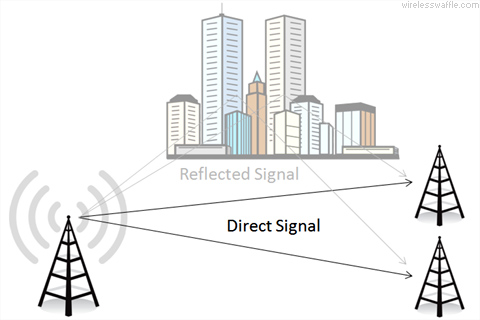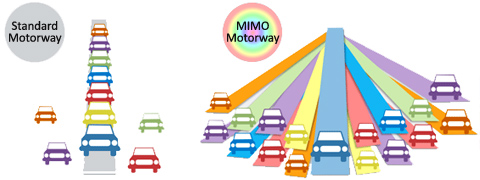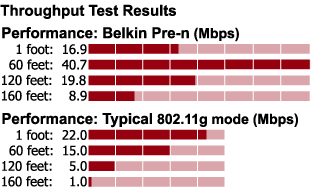Wireless Waffle intends to focus on developments in 5G mobile services amongst our usual flotsam and jetsam of scepticism and general incredulity over wireless matters. But what makes 5G different from 4G, or for that matter 4G from 3G? How are the ever faster connection speeds accomplished, and what are the implications for me and you? Over a series of posts, we intend to explain a little of what is behind these advances in mobile technology, which if nothing else, will serve to show just how sophisticated modern mobile networks are.
In old fashioned radio technologies, the transmitter uses a single antenna to emit a signal, and the receiver uses a single antenna to receive the signal (incidentally known as single input, single output or SISO). This works fine but neglects one of the most common propagation conditions that can upset reception of a radio signal: reflections. The reception of a signal reflected off an object in addition to the direct signal can lead to all manner of problems. One of the most common was, in the days of analogue television, what was known as 'ghosting'.
 Analogue television pictures are drawn line-by-line by a dot that whizzes across the screen from left to right. Any reflection will, by the simple laws of geometry, have travelled further than one directly from the transmitter and thus will take slightly longer to arrive. This produces a second image, that is 'delayed' compared to the direct signal, and this delayed picture would appear to the left of the main signal, as a ghost of the main picture.
Analogue television pictures are drawn line-by-line by a dot that whizzes across the screen from left to right. Any reflection will, by the simple laws of geometry, have travelled further than one directly from the transmitter and thus will take slightly longer to arrive. This produces a second image, that is 'delayed' compared to the direct signal, and this delayed picture would appear to the left of the main signal, as a ghost of the main picture.
In digital television, this problem has been dealt with by slowing down the transmission of the data, such that the typical length of a delay (measured in microseconds) is far less than the length of time used to send each bit, and thus you can effectively ignore the short period of time for which the delayed signal and the direct signal might be different from each other and switch off the receiver for a short while until the situation settles down. The time which the receiver waits for the situation to settle down is known as the guard interval and can be adjusted by the broadcaster to take account of different reflection environments (i.e. in a city where reflections tend to be strong, but over small distances, compared to in a rural area where the reflections might be from buildings or structures several kilometers away).

But what if you could be cleverer than just ignoring the reflection, and find a way of using it to benefit reception instead of being a detriment to it? Take the example illustrated above. A single transmitter is being received by two adjacent antennas, but as well as receiving a signal that has travelled directly from the transmitter, they are also receiving a reflection. If the signal being received at each antenna is compared with the other, the direct signal will appear identical, having travelled exactly the same distance. The reflection, however, will be different at each antenna, having travelled marginally different distances.
This fact can be used to do something very clever. If you compare the signals at both antennas, and only seek out the elements that are identical, you can effectively filter out the direct signal and throw away the reflection. However, you can go one step further. If you subtract the signal at one antenna from that of the other, the direct signal will cancel out, and you will be left with only the reflected signal. Thus it is possible to receive both the direct signal and the reflected signal independently from one another.
Now imagine you could tell the transmitter this information (i.e. that you were receiving two copies of the signal it was transmitting, one directly and one via a reflection). Using the same techniques but in reverse, it would be possible for the transmitter to send two independent sets of information, one via the direct path, and one via the reflection. You could use the same frequency twice between the same two points, doubling spectrum efficiency in one swipe. By using more antennas, more reflections can be handled and the same frequency can be re-used multiple times.
Such techniques are not science-fiction. One of the most important developments of recent years is the implementation of what is known as Multiple Input, Multiple Output (MIMO) technology. MIMO uses more than one antenna both at the transmitter and receiver to achieve exactly this outcome. One of the first widespread uses of MIMO was in the IEEE 802.11n standard for WiFi. This can use up to 4 antennas for the transmitter and up to 4 for the receiver. As reflections are common indoors (e.g. from walls, ceilings) this works very well and allows the same frequency to be re-used multiple times to achieve higher data throughput (theoretically up to 600 Mbps). This technique has been built into WiFi hotspots, laptops and mobile phones since the early 2010s and is now defacto in new devices.
 4G (LTE) also uses MIMO techniques to do exactly the same thing. It is becoming increasingly common for at least 4 antennas to be used at the base station and 2 or more in a mobile handset. Where 5G will change this, is that what is being called 'massive MIMO' will be employed. This means that the base station may have up to 256 antennas, and potentially something similar in handsets. This will allow the same frequencies to be reused hundreds of times within a cell, making spectrum efficiency very high, but also massively increasing the capacity of a cell and thus the connection speed experienced by the users.
4G (LTE) also uses MIMO techniques to do exactly the same thing. It is becoming increasingly common for at least 4 antennas to be used at the base station and 2 or more in a mobile handset. Where 5G will change this, is that what is being called 'massive MIMO' will be employed. This means that the base station may have up to 256 antennas, and potentially something similar in handsets. This will allow the same frequencies to be reused hundreds of times within a cell, making spectrum efficiency very high, but also massively increasing the capacity of a cell and thus the connection speed experienced by the users.
You might think that 256 antennas will weigh down cell towers, but as we are mostly talking about frequencies above 24 GHz, which have a wavelength of 1.2 cm or less, an array of 16 antennas high by 16 across (i.e. 256 in total) need only be 20 cm square. Even at lower frequencies such as 2.6 GHz which has a wavelength of 12 cm, and a panel of 4 antennas wide by 8 high, each antenna having both horizontal and vertical polarisation (making for 64 MIMO antennas) would only measure roughly 50 cm across and 1 m high, which is not that much bigger than traditional panel antennas used today. The picture on the left is of a 2.6 GHz MIMO panel antenna in use at the 5G Innovation Centre in the UK.
Another way to think about massive MIMO is to consider that with 256 antennas, you could use them in the same way as elements of a directional antenna, and form narrow beams pointing at each user. Each user could then use the full amount of spectrum that is available in the cell (or more if there are enough spare antennas to also handle the reflections). This is known as beamforming, and is one of the applications of MIMO.

The impact of massive MIMO has been likened to that of using a multi-lane motorway. On a standard motorway, each car shares a few lanes with other drivers and thus is constrained in what it can do by the other cars on the road. On a massive MIMO motorway, each car has its own lane and thus can do what it wishes.
There is one potential concern that MIMO brings. If you imagine all 256 antennas pointing in the same direction, the cumulative amount of radio energy being sent in that direction could be very high and some have expressed fears that this may exceed safety thresholds. The ITU has even held a workshop on the topic. The concerns also centre around the fact that it is foreseen that 5G cell deployments will be on structures such as street and traffic lights which put them much closer to pedestrians and drivers than existing deployments. Nonetheless, massive MIMO is a key part of 5G technology and will bring significant gains in spectrum efficiency.
In old fashioned radio technologies, the transmitter uses a single antenna to emit a signal, and the receiver uses a single antenna to receive the signal (incidentally known as single input, single output or SISO). This works fine but neglects one of the most common propagation conditions that can upset reception of a radio signal: reflections. The reception of a signal reflected off an object in addition to the direct signal can lead to all manner of problems. One of the most common was, in the days of analogue television, what was known as 'ghosting'.
 Analogue television pictures are drawn line-by-line by a dot that whizzes across the screen from left to right. Any reflection will, by the simple laws of geometry, have travelled further than one directly from the transmitter and thus will take slightly longer to arrive. This produces a second image, that is 'delayed' compared to the direct signal, and this delayed picture would appear to the left of the main signal, as a ghost of the main picture.
Analogue television pictures are drawn line-by-line by a dot that whizzes across the screen from left to right. Any reflection will, by the simple laws of geometry, have travelled further than one directly from the transmitter and thus will take slightly longer to arrive. This produces a second image, that is 'delayed' compared to the direct signal, and this delayed picture would appear to the left of the main signal, as a ghost of the main picture. In digital television, this problem has been dealt with by slowing down the transmission of the data, such that the typical length of a delay (measured in microseconds) is far less than the length of time used to send each bit, and thus you can effectively ignore the short period of time for which the delayed signal and the direct signal might be different from each other and switch off the receiver for a short while until the situation settles down. The time which the receiver waits for the situation to settle down is known as the guard interval and can be adjusted by the broadcaster to take account of different reflection environments (i.e. in a city where reflections tend to be strong, but over small distances, compared to in a rural area where the reflections might be from buildings or structures several kilometers away).

But what if you could be cleverer than just ignoring the reflection, and find a way of using it to benefit reception instead of being a detriment to it? Take the example illustrated above. A single transmitter is being received by two adjacent antennas, but as well as receiving a signal that has travelled directly from the transmitter, they are also receiving a reflection. If the signal being received at each antenna is compared with the other, the direct signal will appear identical, having travelled exactly the same distance. The reflection, however, will be different at each antenna, having travelled marginally different distances.
This fact can be used to do something very clever. If you compare the signals at both antennas, and only seek out the elements that are identical, you can effectively filter out the direct signal and throw away the reflection. However, you can go one step further. If you subtract the signal at one antenna from that of the other, the direct signal will cancel out, and you will be left with only the reflected signal. Thus it is possible to receive both the direct signal and the reflected signal independently from one another.
Now imagine you could tell the transmitter this information (i.e. that you were receiving two copies of the signal it was transmitting, one directly and one via a reflection). Using the same techniques but in reverse, it would be possible for the transmitter to send two independent sets of information, one via the direct path, and one via the reflection. You could use the same frequency twice between the same two points, doubling spectrum efficiency in one swipe. By using more antennas, more reflections can be handled and the same frequency can be re-used multiple times.
Such techniques are not science-fiction. One of the most important developments of recent years is the implementation of what is known as Multiple Input, Multiple Output (MIMO) technology. MIMO uses more than one antenna both at the transmitter and receiver to achieve exactly this outcome. One of the first widespread uses of MIMO was in the IEEE 802.11n standard for WiFi. This can use up to 4 antennas for the transmitter and up to 4 for the receiver. As reflections are common indoors (e.g. from walls, ceilings) this works very well and allows the same frequency to be re-used multiple times to achieve higher data throughput (theoretically up to 600 Mbps). This technique has been built into WiFi hotspots, laptops and mobile phones since the early 2010s and is now defacto in new devices.
 4G (LTE) also uses MIMO techniques to do exactly the same thing. It is becoming increasingly common for at least 4 antennas to be used at the base station and 2 or more in a mobile handset. Where 5G will change this, is that what is being called 'massive MIMO' will be employed. This means that the base station may have up to 256 antennas, and potentially something similar in handsets. This will allow the same frequencies to be reused hundreds of times within a cell, making spectrum efficiency very high, but also massively increasing the capacity of a cell and thus the connection speed experienced by the users.
4G (LTE) also uses MIMO techniques to do exactly the same thing. It is becoming increasingly common for at least 4 antennas to be used at the base station and 2 or more in a mobile handset. Where 5G will change this, is that what is being called 'massive MIMO' will be employed. This means that the base station may have up to 256 antennas, and potentially something similar in handsets. This will allow the same frequencies to be reused hundreds of times within a cell, making spectrum efficiency very high, but also massively increasing the capacity of a cell and thus the connection speed experienced by the users.You might think that 256 antennas will weigh down cell towers, but as we are mostly talking about frequencies above 24 GHz, which have a wavelength of 1.2 cm or less, an array of 16 antennas high by 16 across (i.e. 256 in total) need only be 20 cm square. Even at lower frequencies such as 2.6 GHz which has a wavelength of 12 cm, and a panel of 4 antennas wide by 8 high, each antenna having both horizontal and vertical polarisation (making for 64 MIMO antennas) would only measure roughly 50 cm across and 1 m high, which is not that much bigger than traditional panel antennas used today. The picture on the left is of a 2.6 GHz MIMO panel antenna in use at the 5G Innovation Centre in the UK.
Another way to think about massive MIMO is to consider that with 256 antennas, you could use them in the same way as elements of a directional antenna, and form narrow beams pointing at each user. Each user could then use the full amount of spectrum that is available in the cell (or more if there are enough spare antennas to also handle the reflections). This is known as beamforming, and is one of the applications of MIMO.

The impact of massive MIMO has been likened to that of using a multi-lane motorway. On a standard motorway, each car shares a few lanes with other drivers and thus is constrained in what it can do by the other cars on the road. On a massive MIMO motorway, each car has its own lane and thus can do what it wishes.
There is one potential concern that MIMO brings. If you imagine all 256 antennas pointing in the same direction, the cumulative amount of radio energy being sent in that direction could be very high and some have expressed fears that this may exceed safety thresholds. The ITU has even held a workshop on the topic. The concerns also centre around the fact that it is foreseen that 5G cell deployments will be on structures such as street and traffic lights which put them much closer to pedestrians and drivers than existing deployments. Nonetheless, massive MIMO is a key part of 5G technology and will bring significant gains in spectrum efficiency.
add comment
( 421 views )
| permalink
| 



 ( 2.6 / 927 )
( 2.6 / 927 )




 ( 2.6 / 927 )
( 2.6 / 927 )
Friday 22 September, 2017, 09:12 - 5G, Spectrum Management, Much Ado About Nothing
Posted by Administrator
Posted by Administrator
 Whilst much of the world is yet to experience the joy of 4G (LTE) mobile technology, work is ongoing in a variety of prestigious international bodies to put the finishing touches to the specifications for the next generation of mobile technology: 5G. Everybody knows that 4G stands for GGGG, or the stuttering noise you get when buffering a video, but what are the five G's? Simple, it's Girls, Goals, Gambling, Gaming and videos of Grimalkins, which are the cornerstones upon which mobile technologies aim to make their fortune.
Whilst much of the world is yet to experience the joy of 4G (LTE) mobile technology, work is ongoing in a variety of prestigious international bodies to put the finishing touches to the specifications for the next generation of mobile technology: 5G. Everybody knows that 4G stands for GGGG, or the stuttering noise you get when buffering a video, but what are the five G's? Simple, it's Girls, Goals, Gambling, Gaming and videos of Grimalkins, which are the cornerstones upon which mobile technologies aim to make their fortune. Slightly more seriously though, oodles is already beginning to be written about what 5G will deliver, which includes a range of features such as:
- Blazing hot, super, ultra, mega-fast broadband internet.
- Ubiquitous, go-everywhere, global, universal coverage (even in those hard to get at areas such as behind the sofa).
- Instantaneous, low-latency, tactile, real-time connectivity.
- Extremely high reliability, such that the network will only be down for 14 seconds per millennium, which together with low-latency mentioned above, is termed Ultra-Reliable Low Latency Communications (URLLC).
- Capacity to connect thousands of billions of machines (such as coke vending machines and tumble dryers) known as Massive Machine Type Communication (MTC).
- Power consumption so low that batteries only need re-charging once in every 4 years and base stations can run on one lemon per month.
- World peace and an end to global poverty and disease (this might be made up).
5G is being touted as the 'mobile technology to end all mobile technologies' and as a panacea for all ailments. This miraculous technology will provide what some have termed an 'always sufficient connection' which gives the impression of infinite bandwidth - yes, infinite.

- Mobile subscriber numbers have levelled off and average revenue per user (ARPU) is in gentle decline.
- The 5G vision has not been coupled with a business case. The business reality is that there is no new money.
- The business case for the 'jewel in the crown' of 5G � its millimeter Wave (mmWave) solution � makes little sense.
- Regulators and the ITU should not focus on spectrum for 5G - instead they should ensure that spectrum is available for each component [e.g. broadband, critical communications and IoT].
- Academics should have a stronger links to business departments in universities to ensure that technical breakthroughs are actually valuable.
- Large players (e.g. Ericsson, Nokia, Qualcomm, Huawei, Cisco and Google) should stop believing that the future is all about Gbit/s data rates.
- Governments should focus on deployment, applications and over-the-top (OTT) services not just spectrum.
 What is odd about both sides of the argument, is that many of the so-called advantages of 5G can almost certainly be delivered by 4G (LTE), especially by the forthcoming super-4G variant known as LTE-Advanced-PRO (3GPP LTE Release 13 and 14) - often termed 4.9G. All that 5G really brings is an explosion in the number of cell sites (which could occur using 4G) and technologies and techniques to allow access to new mmWave spectrum above 24 GHz which, according to Verizon may not be great for mobile services anyway:
What is odd about both sides of the argument, is that many of the so-called advantages of 5G can almost certainly be delivered by 4G (LTE), especially by the forthcoming super-4G variant known as LTE-Advanced-PRO (3GPP LTE Release 13 and 14) - often termed 4.9G. All that 5G really brings is an explosion in the number of cell sites (which could occur using 4G) and technologies and techniques to allow access to new mmWave spectrum above 24 GHz which, according to Verizon may not be great for mobile services anyway:Delivering mmWave broadband connectivity in non-line-of-sight environments, such as suburban and urban areas, is extremely problematic over the last quarter mile, because of foliage and solid constructions.
The European Commission believes that 5G is important. Its 5G Action Plan encourages each and every Member State to have a 5G service in at least one city in their country by 2020. Whether this could be delivered using 4.9G to the satisfaction of the Commission is not clear but Ericsson's definition of a 5G subscription in its Mobility Report is:
a device capable of supporting LTE Evolved or NX, connected to a 5G-enabled network, supporting new use cases
This is effectively saying that 4.9G LTE-Advanced-PRO connections would be considered as 5G subscriptions.
The reality is that the real 5G specifications will not be completed until 2020, hence any service delivered before that date can be a 'pre-5G' service at best - or maybe 4.9G. Plans for 5G services in each EU Member state, at the Winter Olympic Games in Korea in 2018 and the Tokyo Olympic Games in 2020 can only possibly fall into the pre-5G category as there will be no agreed 5G standard by these dates.
That being said, there was a time when the World was awash with 'pre-N' internet routers, which were built before the relevant standard (IEEE 802.11n) was completed. The issue with such pre-standardisation products is generally one of interoperability. Each manufacture would have had to have implemented a variation of the standard as they thought it would be finally ratified and these may have been different. Thus whilst a pre-N Netgear router may have worked with a pre-N Netgear WiFi dongle, it wasn't guaranteed to work with a TP-Link, Belkin or a Linksys one.
 For WiFi, that's probably not such a big problem, not least as if the 'N' connection failed, the router and dongle could fall back to an agreed, but less whizzy standard such as 802.11g and thus whilst the benefits of the newer standard wouldn't be realised, the WiFi would still work.
For WiFi, that's probably not such a big problem, not least as if the 'N' connection failed, the router and dongle could fall back to an agreed, but less whizzy standard such as 802.11g and thus whilst the benefits of the newer standard wouldn't be realised, the WiFi would still work. This may be what happens with the pre-5G mobile networks. Japan, for example, has a number of domestic mobile phone manufacturers (e.g. Sony, Sharp, Panasonic) who could agree to make pre-5G phones to whichever standard the Japanese mobile operators chose to roll-out. But for anyone else visiting the country (e.g. for the 2020 Olympic Games) with phones made by other manufacturers, they would just fall back to 4G and not enjoy the benefits of 5G. In such a way, Japan could claim to be offering a 5G service, but it would not be one that was internationally compatible.
So whilst 5G may yet save the world, it is unlikely to do so by 2020 unless you happen to live in a country which has its own mobile manufacturers, live in one of the minute areas where coverage will exist, happen to be there on a day when the 5G service is actually working, and have bought a locally produced 5G phone (or have been provided with one as a guinea pig to test the service). For the rest of us, its going to be more like 2023 or 2025 before real 5G services begin to make a difference to our daily lives and the (perfectly adequate) 4G service we already enjoy will, for now, have to be largely sufficient (though this doesn't make such a compelling strap-line for mobile operators' marketing departments).


